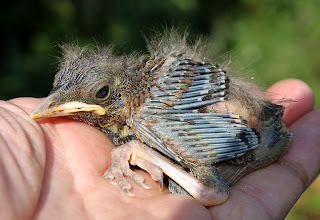Sunday evening Will and I met out on the moss to look for roosts, or at least birds heading to roosts, finches and Swallows. As were going to be there for a while we decided to put up a couple of nets in the hope of intercepting some evening movement.
There seemed plenty of Willow Warblers flitting around in the warm, muggy conditions. It didn’t take long to catch 7 new ones to add to the 12 caught there yesterday and the 3 on Wednesday. We also caught a couple of extra Whitethroat.


About 7pm we noticed good numbers of Goldfinches heading in smallish groups towards the plantation, plus twos and threes of Linnets and even a party of 5 Yellowhammers. By 2030 the Goldfinches were more or less all in, roosting in the densest area of trees towards the north end of the planation. By this time we had counted 300+ Goldfinches from a south and east direction going into the roost, but from our position couldn’t see arrivals from the north or the west. We caught 5 new Goldfinch, all juveniles, but now we have sussed out the Goldfinches preferred roosting spots we may well have a go at a more serious catch on another evening.


Swallows spent the evening feeding over the barley and silage fields until about 9pm the largest numbers swarmed over fields to the south east of us in the direction of St Michaels village. How does one count a dark mass of evening Swallows? But we finally estimated in excess of 4,000 birds which could well have been double the amount. We saw 20+ House Martins during the early evening and then a single Swift heading south.
It was a fascinating evening, one that ended on more highs with sight of the resident Little Owl then 2 Tawny Owls in the spot where I photographed a young bird just a couple of weeks ago.
















































.jpeg)



.jpg)













